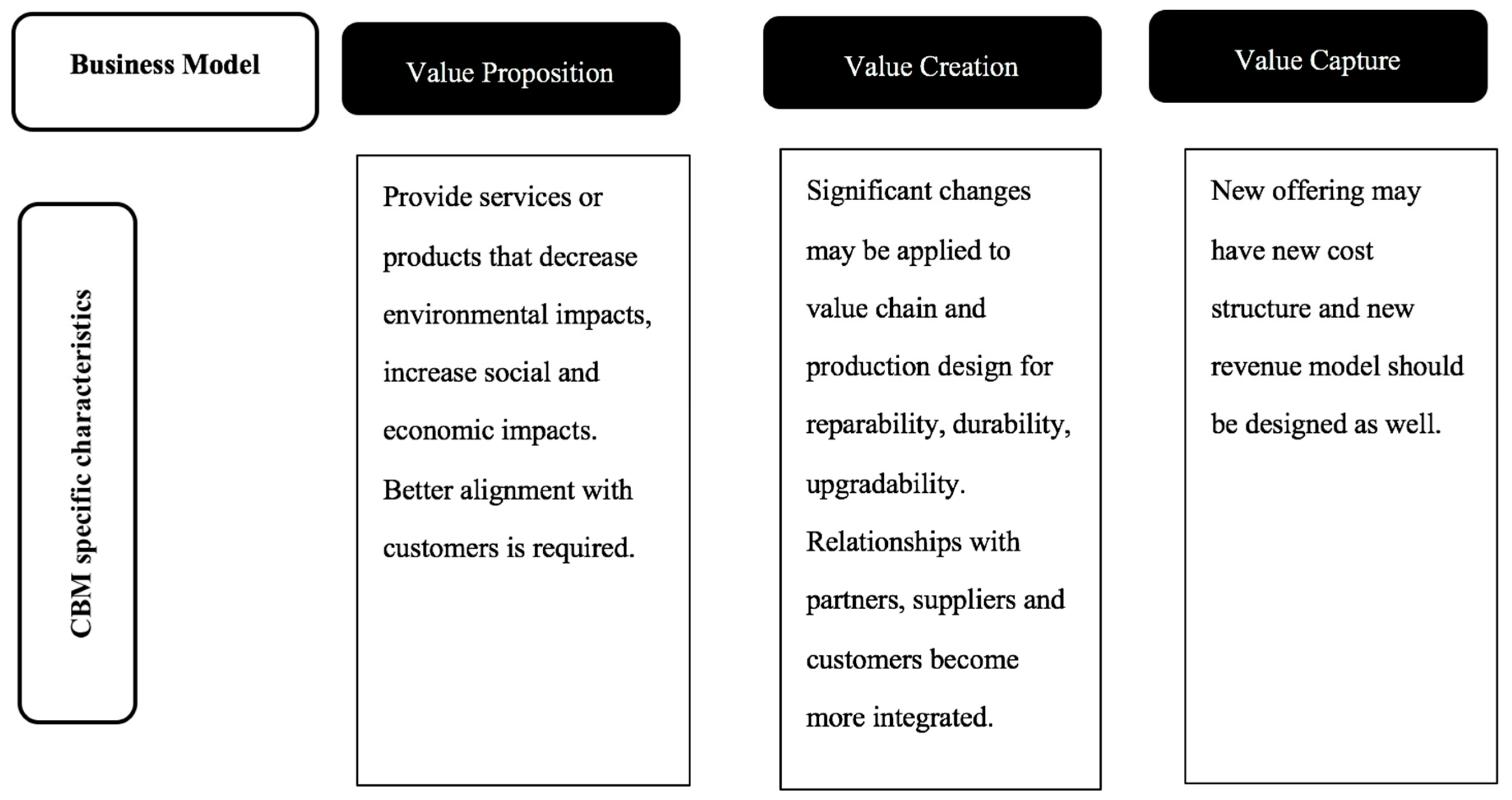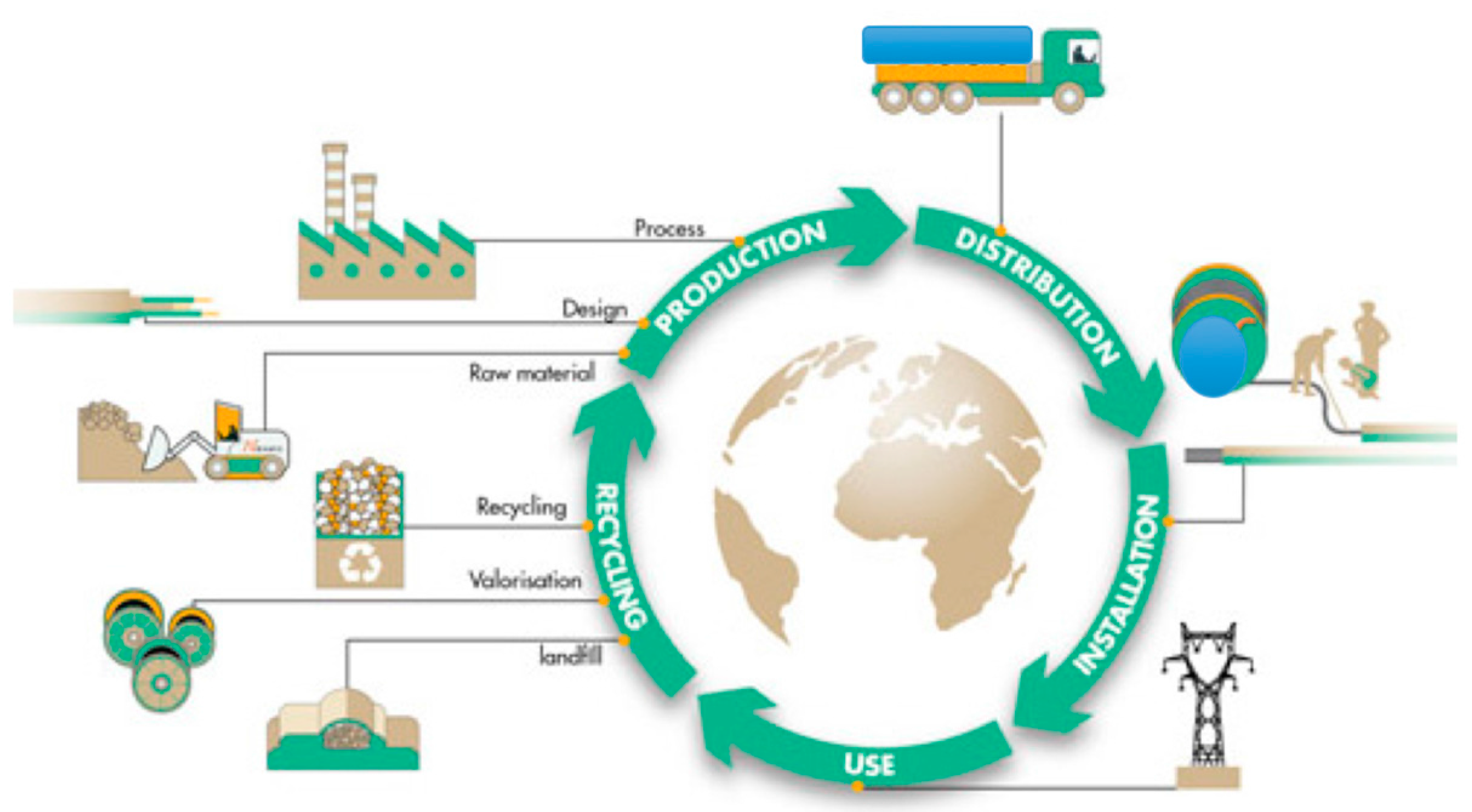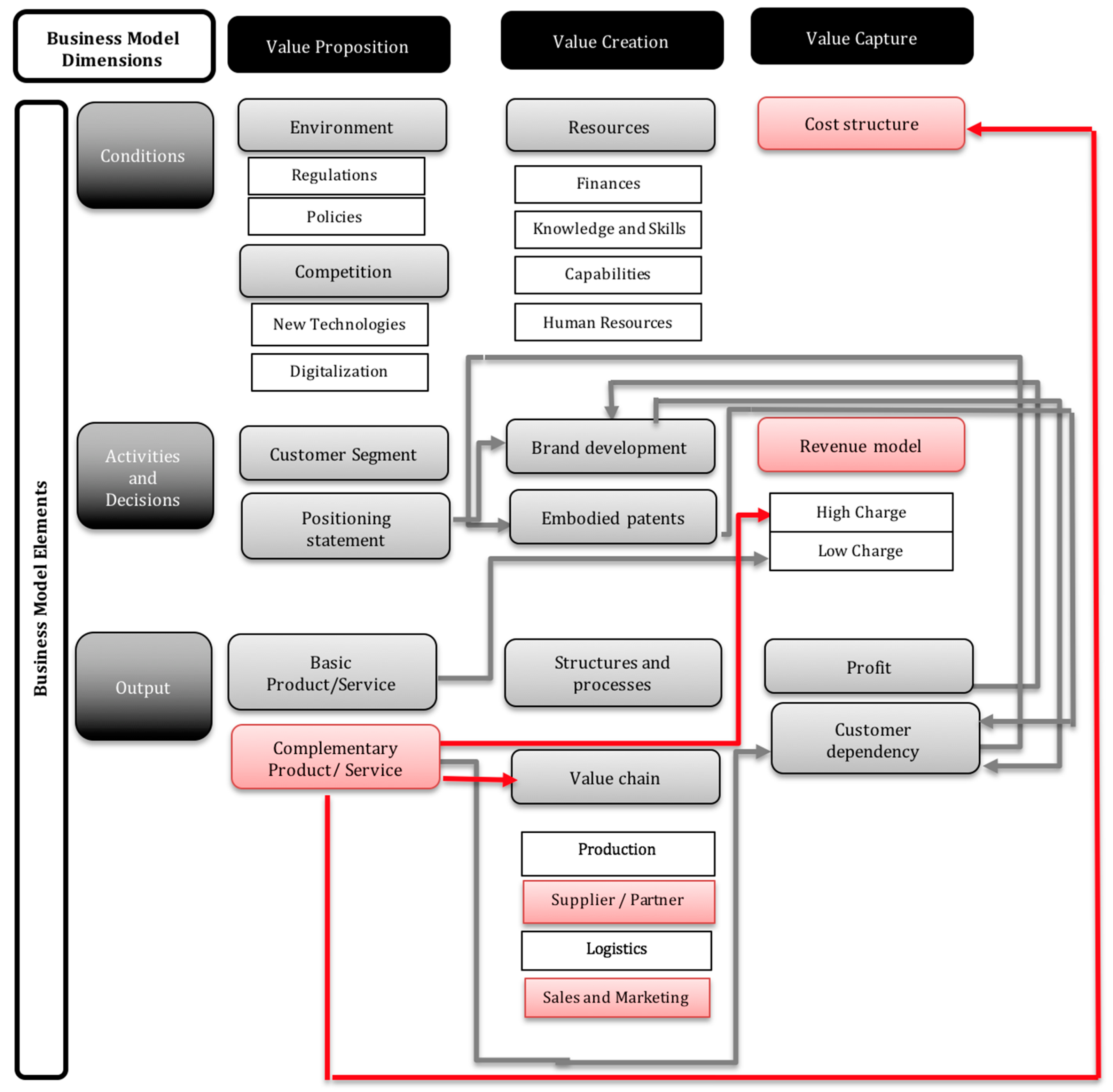Circular Business Model Challenges and Lessons Learned—An Industrial Perspective
Abstract
:1. Introduction
2. Literature Review
2.1. Circular Economy
2.2. Business Model (BM)
2.3. Business Model Innovation (BMI)
2.4. Circular Business Model (CBM)
2.5. CBM Transition
2.6. CBM Archetypes
2.7. CBM Challenges
2.8. CBM Performance
3. Methodology
3.1. Context of Study
3.2. Case Selection
3.3. Data Collection
3.4. Data Analysis Procedure
3.5. Quality Criteria
4. Data Analysis and Results
4.1. Data Analysis and Results of Multiple Case Studies
CBM Archetypes
4.2. Challenges of CBM
5. Discussion and Conclusions
Limitations and Suggestions for Future Studies
Acknowledgments
Author Contributions
Conflicts of Interest
References
- Bechtel, N.; Bojko, R.; Völkel, R. Be in the Loop: Circular Economy & Strategic Sustainable Development. Master’s Thesis, School of Engineering, Blekinge Institute of Technology, Karlskrona, Sweden, 2013. [Google Scholar]
- Schulte, U.G. New business models for a radical change in resource efficiency. Environ. Innov. Soc. Transit. 2013, 9, 43–47. [Google Scholar] [CrossRef]
- China Chemical Reporter. AkzoNobel Sustainability Expert Calls for New Mindset for Radical Resource Efficiency, Finance and Business. 2014. Available online: http://www.ccr.com.cn/home/index/search.html?keywords=AkzoNobel+Sustainability+ (accessed on 15 January 2018).
- Mostaghel, R.; Oghazi, P.; Haftor, D.; Parida, V.; Vincent, J. Circular Business Models: What are they? In Proceedings of the 24th Nordic Academy of Management Conference (NFF), Bodo, Norway, 23–25 August 2017. [Google Scholar]
- Lewandowski, M. Designing the Business Models for Circular Economy—Towards the Conceptual Framework. Sustainability 2016, 8, 43. [Google Scholar] [CrossRef]
- Nußholz, J.L. Circular Business Models: Defining a Concept and Framing an Emerging Research Field. Sustainability 2017, 9, 1810. [Google Scholar] [CrossRef]
- Lewandowski, M. How cultural organisations use digital technologies to enhance circular business models. Int. J. Environ. Policy Decis. Mak. 2017, 2, 79–97. [Google Scholar] [CrossRef]
- Planing, P. Business model innovation in a circular economy reasons for non-acceptance of circular business models. Open J. Bus. Model Innov. 2015, in press. [Google Scholar]
- Rizos, V.; Behrens, A.; van der Gaast, W.; Hofman, E.; Ioannou, A.; Kafyeke, T.; Flamos, A.; Rinaldi, R.; Papadelis, S.; Hirschnitz-Garbers, M.; et al. Implementation of circular economy business models by small and medium-sized enterprises (SMEs): Barriers and enablers. Sustainability 2016, 8, 1212. [Google Scholar] [CrossRef]
- European Commission. Communication from the Commission to the European Parliament, the Council, the European Economic and Social Committee and the Committee of the Regions: Closing the Loop—An EU Action Plan for the Circular Economy; European Commission: Brussels, Belgium, 2015. [Google Scholar]
- Copenhagen IRIS. Circular Economy Workshop. April 2015. Available online: http://www.copenhageniris.com/circular-economy-workshop-april-2015.html (accessed on 16 January 2017).
- Almedalsveckan. Program 2015—Almedalsveckan. Available online: http://www.almedalsveckan.info/event/list/2015#p1 (accessed on 16 January 2017).
- European Environment Agency (EEA). Survey of Resource Efficiency Policies in EEA Member and Cooperating Countries—COUNTRY PROFILE: Sweden. Country Information on Resource Efficiency policies, Instruments, Objectives, Targets and indicators, Institutional Setup and Information Needs. 2011. Available online: http://www.eea.europa.eu/resource-efficiency (accessed on 16 January 2017).
- Ghisellini, P.; Cialani, C.; Ulgiati, S. A review on circular economy: The expected transition to a balanced interplay of environmental and economic systems. J. Clean. Prod. 2016, 114, 11–32. [Google Scholar] [CrossRef]
- Lieder, M.; Rashid, A. Towards circular economy implementation: A comprehensive review in context of manufacturing industry. J. Clean. Prod. 2016, 115, 36–51. [Google Scholar] [CrossRef]
- Genovese, A.; Acquaye, A.; Figueroa, A.; Lenny Koh, S.C. Sustainable supply chain management and the transition towards a circular economy: Evidence and some applications. Omega 2017, 66, 344–357. [Google Scholar] [CrossRef]
- Ellen MacArthur Foundation. 2015. Available online: http://www.ellenmacarthurfoundation.org/circular-economy/interactive-diagram (accessed on 17 January 2017).
- Singh, J.; Ordoñez, I. Resource recovery from post-consumer waste: Important lessons for the upcoming circular economy. J. Clean. Prod. 2016, 134, 342–353. [Google Scholar] [CrossRef]
- Richardson, J. The business model: An integrative framework for strategy execution. Strateg. Chang. 2008, 17, 133–144. [Google Scholar] [CrossRef]
- Teece, D.J. Business Models, Business Strategy and Innovation. Long Range Plan. 2010, 43, 172–194. [Google Scholar] [CrossRef]
- Geissdoerfer, M.; Savaget, P.; Bocken, N.M.; Hultink, E.J. The Circular Economy—A new sustainability paradigm? J. Clean. Prod. 2017, 143, 757–768. [Google Scholar] [CrossRef]
- Gorissen, L.; Vrancken, K.; Manshoven, S. Transition thinking and business model innovation–towards a transformative business model and new role for the reuse centers of Limburg, Belgium. Sustainability 2016, 8, 112. [Google Scholar] [CrossRef]
- McDonough, W.; Braungart, M. Cradle to Cradle: Remaking the Way We Make Things; MacMillan: London, UK, 2010. [Google Scholar]
- Barquet, A.P.; Seidela, J.; Seligera, G.; Kohl, H. Sustainability factors for PSS business models. Procedia CIRP 2016, 47, 436–441. [Google Scholar] [CrossRef]
- Mentink, B. Circular Business Model Innovation: A Process Framework and A Tool for Business Model Innovation in A Circular Economy. Master’s Thesis, Delft University of Technology & Leiden University, Leiden, The Netherlands, 2014. [Google Scholar]
- Vandermerwe, S.; Rada, J. Servitization of business: Adding value by adding services. Eur. Manag. J. 1988, 6, 314–324. [Google Scholar] [CrossRef]
- Mont, O.; Tukker, A. Product-Service Systems: Reviewing achievements and refining the research agenda. J. Clean. Prod. 2006, 14, 1451–1454. [Google Scholar] [CrossRef]
- Bocken, N.M.; Ritala, P.; Huotari, P. The Circular Economy: Exploring the Introduction of the Concept Among S&P 500 Firms. J. Ind. Ecol. 2017, 21, 487–490. [Google Scholar]
- Prendeville, S.; Bocken, N. Sustainable Business Models through Service Design. Procedia Manuf. 2017, 8, 292–299. [Google Scholar] [CrossRef]
- Koen, P.A.; Bertels, H.M.; Elsum, I.R. The three faces of business model innovation: Challenges for established firms. Res. Technol. Manag. 2011, 54, 52–59. [Google Scholar] [CrossRef]
- Linder, M.; Williander, M. Circular Business Model Innovation: Inherent Uncertainties. Bus. Strategy Environ. 2015, 26, 182–196. [Google Scholar] [CrossRef]
- Bocken, N.M.P.; de Pauw, I.; Bakker, C.; van der Grinten, B. Product design and business model strategies for a circular economy. J. Ind. Prod. Eng. 2016, 33, 308–320. [Google Scholar] [CrossRef]
- De Winter, J. Circular Business models: An Opportunity to Generate New Value, Recover Value and Mitigate Risk Associated with Pressure on Raw Material Availability and Price Volatility. Master’s Thesis, Faculty of Geosciences, Utrecht University, Utrecht, The Netherlands, 2014. [Google Scholar]
- Beattie, V.; Smith, S. Value creation and business models: Refocusing the intellectual capital debate. Br. Account. Rev. 2013, 45, 243–254. [Google Scholar] [CrossRef]
- Stubbs, W.; Cocklin, C. Conceptualizing a “sustainability business model”. Org. Environ. 2008, 21, 103–127. [Google Scholar] [CrossRef]
- Kok, L.; Wurpel, G.; Ten Wolde, A. The Circle Economy/IMSA Amsterdam. In Unleashing the Power of the Circular Economy; A Report for Circle Economy; The Circle Economy/IMSA Amsterdam: Amsterdam, The Netherlands, 2013. [Google Scholar]
- Tukker, A. Eight types of product-service system: Eight ways to sustainability? Bus. Strategy Environ. 2004, 13, 246–260. [Google Scholar] [CrossRef]
- Grant, R.M. Contemporary Strategy Analysis; John Wiley & Sons Ltd.: Chichester, UK, 2010; ISBN 9781119120841. [Google Scholar]
- Moors, E.; Mulder, K.; Vergragt, P. Towards cleaner production: Barriers and strategies in the base metals producing industry. J. Clean. Prod. 2005, 13, 657–668. [Google Scholar] [CrossRef]
- Produktion2030. Expertområde 5: Produkt-och Produktionsbaserade Tjänster Vision, Nulägesanalys, Utmaningar och Effektmål; Produktion 2030: Stockholm, Sweden, 2014. [Google Scholar]
- Liu, Y.; Bai, Y. An exploration of firms’ awareness and behaviour of developing circular economy: An empirical research in China. Resour. Conserv. Recycl. 2013, 87, 145–152. [Google Scholar] [CrossRef]
- Rizos, V.; Behrens, A.; Kafyeke, T.; Hirschnitz-Garbers, M.; Ioannou, A. The Circular Economy: Barriers and Opportunities for SMEs, GreenEcoNet, Financed by the 7th EU Framework Program. 2015. No. 412. Available online: https://www.researchgate.net/publication/283121970_The_Circular_Economy_Barriers_and_Opportunities_for_SMEs (accessed on 17 January 2017).
- Westblom, C. Towards a Circular Economy in Sweden-Barriers for New Business Models and the Need for Policy Intervention. Master’s Thesis, The International Institute for Industrial Environmental Economics (IIIEE), Lund University, Lund, Sweden, 2015. [Google Scholar]
- Vanner, R.; Bicket, M.; Withana, S.; ten Brink, P.; Razzini, P.; van Dijl, E.; Watkins, E.; Hestin, M.; Tan, A.; Guilcher, S. Scoping Study to Identify Potential Circular Economy Actions, Priority Sectors, Material Flows & Value Chains. Study Prepared for the European Commission, DG Environment. 2014. Available online: http://www.psi.org.uk/site/project_detail/1729 (accessed on 17 January 2017).
- Hoffman, A.J.; Bazerman, M.H. Changing practice on sustainability: Understanding and overcoming the organizational and psychological barriers to action. In Organizations and the Sustainability Mosaic, Crafting Long-Term Ecological and Societal Solutions; Edward Elgar Publishing: Camberley, UK, 2007; pp. 84–105. [Google Scholar]
- Mont, O.; Dalhammar, C.; Jacobsson, N. A new business model for baby prams based on leasing and product remanufacturing. J. Clean. Prod. 2006, 14, 1509–1518. [Google Scholar] [CrossRef]
- Besch, K. Product-service systems for office furniture: Barriers and opportunities on the European market. J. Clean. Prod. 2005, 13, 1083–1094. [Google Scholar] [CrossRef]
- Berglund, H.; Sandström, C. Business model innovation from an open systems perspective: Structural challenges and managerial solutions. Int. J. Prod. Dev. 2013, 18, 274–285. [Google Scholar] [CrossRef]
- Kalmykova, Y.; Rosado, L.; Patrício, J. Resource consumption drivers and pathways to reduction: Economy, policy and lifestyle impact on material flows at the national and urban scale. J. Clean. Prod. 2016, 132, 70–80. [Google Scholar] [CrossRef]
- De los Rios, I.C.; Charnley, F.J. Skills and capabilities for a sustainable and circular economy: The changing role of design. J. Clean. Prod. 2016, 160, 109–122. [Google Scholar] [CrossRef]
- Haggége, M.; Gauthier, C.; Rüling, C.-C. Business model performance: Five key drivers. J. Bus. Strategy 2017, 38, 6–15. [Google Scholar] [CrossRef]
- Bakker, C.; Wang, F.; Huisman, J.; den Hollander, M. Products that go round: Exploring product life extension through design. J. Clean. Prod. 2014, 69, 10–16. [Google Scholar] [CrossRef]
- Lee, S.; Geum, Y.; Lee, H.; Park, Y. Dynamic and multidimensional measurement of product-service system (PSS) sustainability: A triple bottom line (TBL)-based system dynamics approach. J. Clean. Prod. 2012, 32, 173–182. [Google Scholar] [CrossRef]
- Maxwell, J.A. Qualitative Research Design: An Interactive Approach; Sage: California, VA, USA, 2005. [Google Scholar]
- Voss, C.; Tsikriktsis, N.; Frohlich, M. Case research in operations management. Int. J. Oper. Prod. Manag. 2002, 22, 195–219. [Google Scholar] [CrossRef]
- Yin, R.K. Case Study Research; Sage Publications, Inc.: California, VA, USA, 1994. [Google Scholar]
- Liu, C.L.E.; Zhang, Y. Learning process and capability formation in cross-border buyer–supplier relationships: A qualitative case study of Taiwanese technological firms. Int. Bus. Rev. 2014, 23, 718–730. [Google Scholar] [CrossRef]
- Boyatzis, E. Transforming Qualitative Information: Thematic Analysis and Code Development? Sage: London, UK, 1998. [Google Scholar]
- Corbin, J.; Strauss, A. Grounded theory research: Procedures, canons, and evaluative criteria. Qual. Sociol. 1990, 13, 3–21. [Google Scholar] [CrossRef]
- Palmatier, R.W.; Sridhar, S. Marketing Strategy; Palgrave: London, UK, 2017; ISBN 9781137526236. [Google Scholar]
- Abdelkafi, N.; Makhotin, S.; Posselt, T. Business Model Innovations for Electric Mobility—What can be Learned from Existing Business Model Patterns? Int. J. Innov. Manag. 2013, 17, 1–41. [Google Scholar] [CrossRef]
- Abdelkafi, N.; Täuscher, K. Understanding the Basic Functioning of Business Models: A Graphical Approach for Theoretical Analysis and Tool Development. In Proceedings of the 25th ISPIM Conference, Dublin, Ireland, 8–12 June 2014; p. 1. [Google Scholar]




| Challenges of CBM | Description |
|---|---|
| Lack of Supporting Regulation | Lack of supporting regulations, complexity and inconsistency of regulations [1,8,31,42,43,44]. |
| Organizational barriers | Change is difficult for organizations and individuals [1]. Restructuring is costly and risky, resistance among managers benefiting the current structure might rule out the expected benefits for the firm and the environment [45]. |
| Cultural barriers | Fear of the unknown is a barrier for organizations [45]. |
| Financial and economic barriers | Major up-front investment costs, recycled materials are often still more expensive in CBM rather than in linear business models [36]. Different skills and resources can be more expensive [37]. |
| Technological barriers | Lack of methods for handling life cycle of products data [36]. Limited availability and quality of recycling materials [36]. Technological limitations for recycling, product design, and other processes have been identified as major barriers for CBM adoption [1]. |
| Customer Type Restrictions | Customers want to have ownership, particularly in B2C area [37]. Customer is careless when leasing [31,37]. Lack of customers’ knowledge on origins of products [37]. |
| Product Category Restrictions | Product category restrictions would be a barrier [31]. Lack of resources for designing products adopted for reuse, repair and remanufacture [44]. |
| Fashion Vulnerability | Since CBM strives to slow down or close the life cycle of materials and products ([32]), fashion could be a barrier for high quality products [31,46,47]. |
| Risk of Cannibalization | Risk of cannibalization similar to fashion vulnerability hinders production of long-lasting high quality products [31]. |
| Return Flow Challenges | Exchange of materials is limited by capacity of reverse logistics [36]. Return flow challenges are barriers to CBM adoption [31]. |
| Lack of channel control | Lack of channel control and conflict of interest within firms are barriers to CBM adoption [8,31]. |
| Confidentiality for individual firms | Information exchange between all actors in CE can conflict with confidentiality and related competitive position of an individual firm [24,36]. |
| Trust among partners | CBM is based on collaboration, and that requires trust between parties [48]. |
| Mutual benefits for all partners | Mutual benefits among all stakeholders are necessary for collaboration [24]. Misaligned profit sharing along supply chain would hinder CBM adoption [8]. |
| Increase of dependency to partners | Partners work closely and increase dependency on each other which is considered a risk that must be controlled [24]. |
| Higher risks for CBM | Validation is not achievable without later sales and that risk of resource exposal grows during the validation [31]. |
| Firm 1 | Firm 2 | Firm 3 | Firm 4 | Firm 5 | Firm 6 | |
|---|---|---|---|---|---|---|
| Turnover 2016 | 2586 M€ | 11,072 M€ | 2550 M€ | 13,461 M€ | 3 M€ | 191 M€ |
| Employee number | 11220 | 40286 | 3690 | 18046 | 10 | 490 |
| Business scope | Processing industries | Heavy trucks | Customer support agreements | Luxury car-sharing services | Services for hospitals | Paper cable packaging |
| Alliance partners | Boliden, LKAB, ABB, Remard Industry, Pöyry Group, Bosch Rexroth | Ziegler group, Vendelbo Spedition A/S, M&M Militzer & Munch and Asta Logistik Grupo | Swecon, FAMCO, SMT, Kuiken, CJD | Sunfleet, and Tobin Properties | Smith & Nephew, non-disclosed service delivery company | Ahlsell, Borealis, Elektrokoppar, Spitze, and Stora Enso |
| Interviewee | (1) Engineer, spares process equipment (2) Process equipment (3) Project service support | (1) Head of service (2) Head of commercial management (3) Director business development | (1) General director (2) New technology and services director (3) Product development director | (1) New technology and services director (2) Product development director | (1) Executive vice president, sales and marketing (2) CEO (3) International service engineer | (1) Production manager (2) Procurement manager (3) Plant manager |
| Firm 1 | Firm 2 | Firm 3 | Firm 4 | Firm 5 | Firm 6 | |
|---|---|---|---|---|---|---|
| Business scope | Processing industries | Heavy trucks | Customer support agreements | Luxury car-sharing services | Services for hospitals | Paper cable packaging |
| CBM archetype | Encourage sufficiency | Encourage sufficiency | Encourage sufficiency | Access and performance model | Encourage sufficiency | Encourage sufficiency and Extending resources value |
| Primary CBM challenge | (1) Value creation—partners (2) Value capture—revenue model | (1) Value proposition—complementary products (2) Value capture—revenue model (3) Value creation—customers | (1) Value chain—partners (2) Value creation—customers (3) Value proposition—complementary | (1) Value capture—revenue model (2) Value proposition—complementary | (1) Value capture—revenue model (2) Value proposition—complementary (3) Value creation—partners | (1) Value creation—partners (2) Value capture—revenue model (3) Value creation—customers |
| Main sustainability benefit | Environmental and economic | Environmental and economic | Environmental and economic | Social, environmental and economic | Social, environmental and economic | Social, environmental and long-term economic |
| Exemplary quote | “We offer a Life Cycle Solution.” | Primary challenge of CBM is “lack of alignment of incentives between the involved actors and units.” | Partnership “was based on a gentlemen’s agreement and trust.” | “We start seeing the needs” of customers. | “… we have to train the trainer. And maybe the information is lost on the way.” | “Not all customers value the sustainable offerings” |
© 2018 by the authors. Licensee MDPI, Basel, Switzerland. This article is an open access article distributed under the terms and conditions of the Creative Commons Attribution (CC BY) license (http://creativecommons.org/licenses/by/4.0/).
Share and Cite
Oghazi, P.; Mostaghel, R. Circular Business Model Challenges and Lessons Learned—An Industrial Perspective. Sustainability 2018, 10, 739. https://doi.org/10.3390/su10030739
Oghazi P, Mostaghel R. Circular Business Model Challenges and Lessons Learned—An Industrial Perspective. Sustainability. 2018; 10(3):739. https://doi.org/10.3390/su10030739
Chicago/Turabian StyleOghazi, Pejvak, and Rana Mostaghel. 2018. "Circular Business Model Challenges and Lessons Learned—An Industrial Perspective" Sustainability 10, no. 3: 739. https://doi.org/10.3390/su10030739




